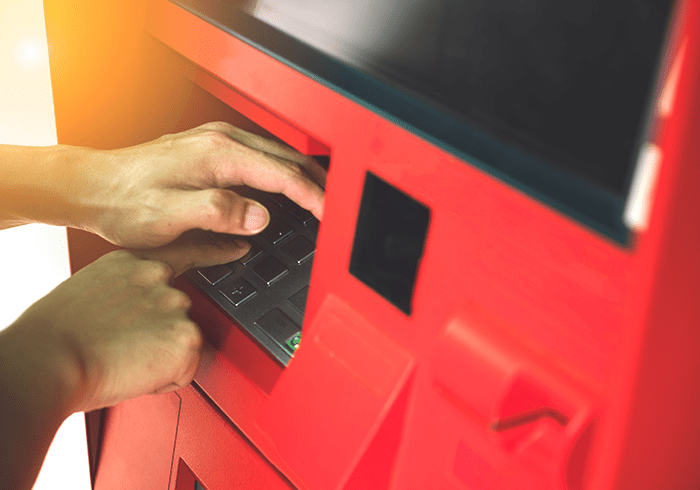PROTECTION FROM CARD SKIMMING

By Chandler Sullivan
February 13, 2024 | 3 Min. Read

By Chandler Sullivan
February 13, 2024 | 3 Min. Read
People use their debit cards for everything from buying groceries to getting gas. The convenience of having debit/credit cards eliminates most needs for cash. But with this convenience comes the risk of credit card skimming. Skimming is a type of fraud where thieves steal your credit or debit card information using a skimming device. This information can then be used to make unauthorized purchases or even create counterfeit cards.
In this blog, we’ll talk about what credit card skimming is and how you can lessen your chances of having your card information stolen.
A credit card skimmer is a small device that can be attached to a legitimate card reader. Swiping your card through the skimmer captures your credit card number, expiration date, and other personal information. Skimmers can be found on ATMs, gas pumps, point-of-sale (POS) terminals, and even parking meters.
The skimming device is so small and discreet that most people wouldn’t notice. Sometimes card skimmers look identical to actual POS terminals or gas card readers, you wouldn’t know unless you moved the card reader itself.
There are two main types of skimmers:
Once the skimmer has captured your information, the thief can download it to a computer or transmit it wirelessly. They can then use this information to create counterfeit cards or make unauthorized purchases online or in stores. Essentially, this can lead to forms of identity theft if the problem isn’t stopped in its tracks.
Now that you are aware of what credit card skimmers are, it is important to know how to avoid card skimming or decrease your chances overall. Let’s talk about how to outsmart these sneaky skimmers and keep your money safe!
Before you put your card in, give the card reader a quick look. Card skimmers are often separate pieces attached over the slot where your card slides in. If it looks weird or loose, it’s better to use a different one.
Use tap to pay or contactless pay whenever you can. These methods are usually safer because the skimmer can’t grab your card info like it can when you slide or dip. This uses Near Field Communication (NFC) technology, which only works over a very short distance (a few centimeters). This makes it virtually impossible for someone to skim your card information in passing. However, some skimming devices can intercept contactless transactions at very close range, so vigilance is still key.
Give the card reader a wiggle. If it feels loose or moves too much, that could be a sign of a skimmer.
Look at your bank statements regularly. If you see any purchases you didn’t make, call your credit union or bank right away.
When you enter your PIN, cover it with your hand. This way, even if there’s a sneaky camera, it won’t see your secret code.
Use your card at places you know and trust. Avoid using your card at weird-looking ATMs or card readers in places that seem a bit off.
If you’re not sure, ask a friend to take a look with you. Two sets of eyes are better than one!
While chip cards are a significant step up from the old magnetic stripe, they don’t completely eliminate the risk of skimming. Skimming devices designed to copy chip data, known as shimmers, do exist, though they’re much less common and easier to detect than magnetic stripe skimmers.
Contactless pay is still considered the safest way to use credit cards. Think of your contactless card as a high-tech shield, constantly evolving to outsmart scammers’ tricks. While no system is foolproof, it’s at the forefront of credit card security, with layers of protection to keep your financial fortress safe.
Don’t leave your financial security to chance! Contact your financial institution immediately. Additionally, explore the fraud alert options offered by your card provider. Early detection is key to minimizing damage, so activate these safeguards and give yourself peace of mind.
If you suspect a skimming device has been placed on a card reader, report it to the manager of the location immediately!
With fraud losses exceeding $5.8 billion in 2021 (a 70% increase!), the FTC warns of the ever-present risk of scams and fraud. But you don’t have to be a victim! By actively managing your finances and staying vigilant, you can shield yourself from these threats.
Marine Credit Union is here to help and offer the resources needed to stay informed. Report any suspicious activity, identity theft, or fraud issues that could affect your accounts to your local Marine Credit Union branch office.